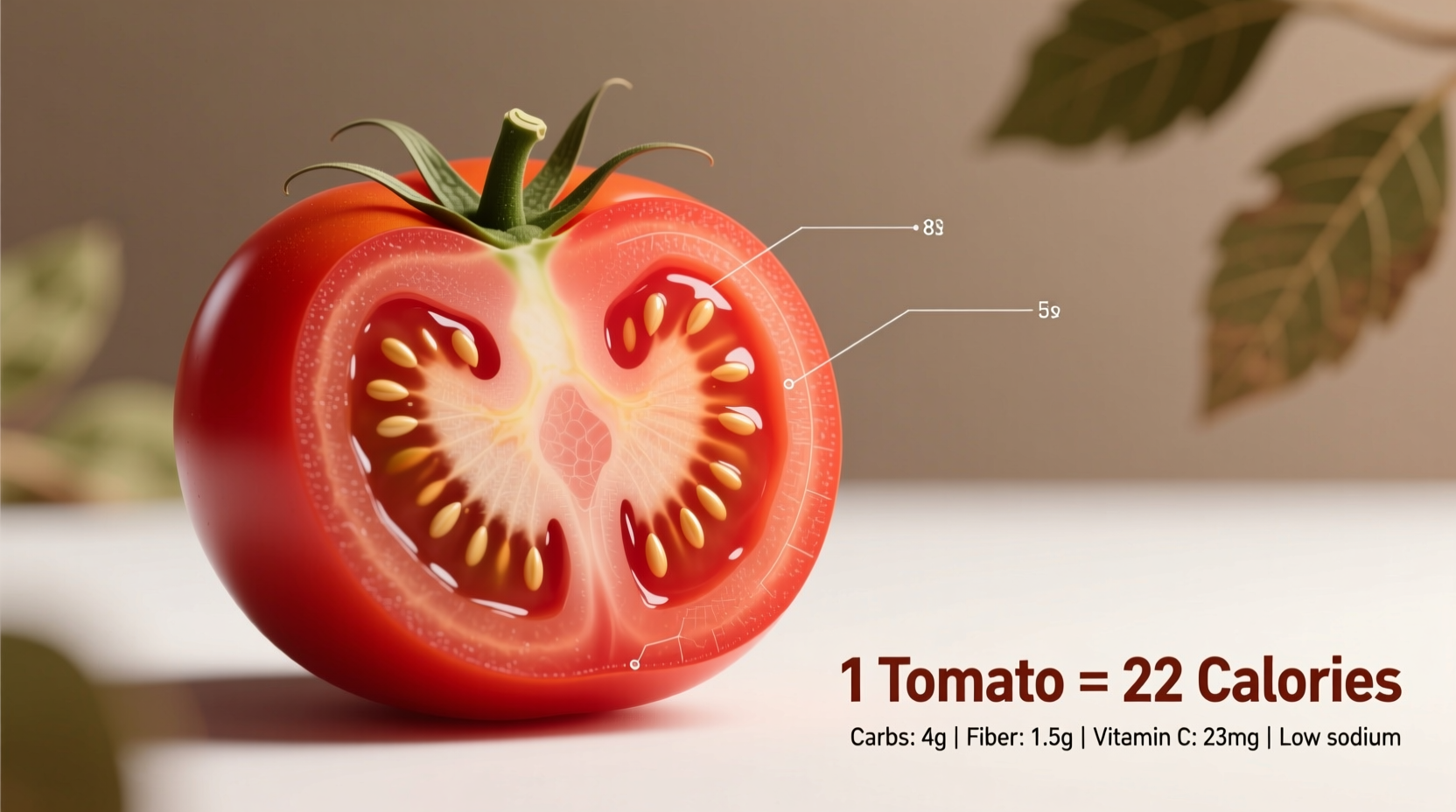Understanding Tomato Calorie Content by Size
When tracking your daily nutrition, knowing the precise calorie count for different tomato sizes is essential. The USDA's FoodData Central provides the most reliable measurements for various tomato types:
| Tomato Type | Average Weight | Calories | Carbohydrates | Key Nutrients |
|---|---|---|---|---|
| Medium tomato | 148 g | 22 | 4.8 g | Vitamin C (28% DV), Vitamin K (12% DV), Potassium |
| Large tomato | 182 g | 33 | 7.5 g | Higher lycopene content, more fiber |
| Small tomato | 100 g | 18 | 3.9 g | Concentrated vitamin profile per gram |
| Cherry tomato (each) | 12 g | 3 | 0.6 g | Higher sugar concentration, portable snack option |
This nutritional fact comparison shows how tomato size directly impacts calorie content. Unlike many fruits where size variations dramatically change nutritional value, tomatoes maintain their nutrient density regardless of size. The USDA has consistently documented these measurements since establishing standardized food composition databases in the 1980s, with minor updates reflecting modern agricultural practices.
Why Tomato Calorie Counts Matter for Your Diet
Understanding the calorie content of single tomatoes helps with precise meal planning. For those monitoring daily intake, a medium tomato represents just 1% of a standard 2,000-calorie diet. What makes tomatoes particularly valuable is their exceptional nutrient-to-calorie ratio:
- Hydration factor - Tomatoes are 95% water, contributing to daily fluid needs
- Fiber content - Each medium tomato provides 1.5 grams of dietary fiber
- Lycopene concentration - This powerful antioxidant becomes more bioavailable when tomatoes are cooked
- Natural sweetness - With only 2.6 grams of natural sugar per medium tomato, they satisfy cravings without blood sugar spikes
Unlike processed low-calorie foods that sacrifice nutrition for reduced calories, tomatoes deliver substantial health benefits while remaining exceptionally low in energy density. This makes them ideal for weight management without compromising nutritional quality.

Practical Applications for Daily Nutrition Tracking
When incorporating tomatoes into your meal planning, consider these practical scenarios:
For Weight Management
Adding one medium tomato (22 calories) to meals increases volume without significant calorie impact. This technique, known as volumetrics, helps create satisfying portions while maintaining calorie goals. For example, adding tomatoes to an omelet increases the meal's size by 30% with minimal calorie addition.
For Blood Sugar Control
With a glycemic load of just 1, tomatoes won't disrupt blood sugar levels. This makes them ideal for diabetic meal planning. The fiber content helps slow carbohydrate absorption from other foods when eaten together.
For Nutrient Optimization
To maximize lycopene absorption, pair tomatoes with healthy fats. A simple salad with one medium tomato, 5g of olive oil, and leafy greens creates a nutritionally complete meal under 100 calories. The fat content increases lycopene bioavailability by up to 400% according to research published in the American Journal of Clinical Nutrition.
Factors That Influence Tomato Calorie Content
While the standard measurements provide reliable guidance, several factors can cause minor variations in tomato calorie counts:
- Varietal differences - Heirloom varieties may contain slightly more natural sugars than standard grocery store tomatoes
- Ripeness level - Fully ripe tomatoes contain marginally more carbohydrates (and thus calories) than underripe ones
- Growing conditions - Soil composition and sunlight exposure affect sugar concentration
- Preparation methods - Cooking concentrates sugars slightly, while draining liquid from sauces reduces overall calories
These variations typically affect calorie counts by less than 10%, making the standard USDA measurements sufficiently accurate for most nutritional tracking purposes. The Academy of Nutrition and Dietetics confirms that for general dietary planning, these minor fluctuations don't significantly impact overall nutrition goals.
Tomatoes in Historical Dietary Context
Tomatoes have evolved significantly since their introduction to European cuisine in the 16th century. Originally grown as ornamental plants due to fears they were poisonous, tomatoes gradually became dietary staples. Modern breeding has focused on:
- Increased disease resistance (1940s-1960s)
- Extended shelf life (1970s-1990s)
- Nutritional enhancement (2000s-present)
Interestingly, historical tomato varieties often contained slightly higher natural sugar content, which would translate to marginally more calories by weight. Today's nutritionally optimized varieties maintain excellent flavor while delivering consistent, reliable nutritional profiles that support modern dietary tracking needs.
Common Questions About Tomato Nutrition
Many people have specific questions about incorporating tomatoes into their nutrition plans. Here are answers to the most frequently asked questions:











 浙公网安备
33010002000092号
浙公网安备
33010002000092号 浙B2-20120091-4
浙B2-20120091-4